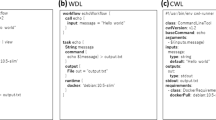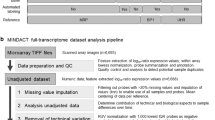Abstract
Microarray technology has undergone a rapid evolution. With widespread interest in large-scale genomic research, an abundance of equipment and reagents have now become available and affordable to a large cross section of the scientific community. As protocols become more refined, careful investigators are able to obtain good quality microarray data quickly. In most recent times, however, perhaps one of the biggest obstacles researchers face is not the manufacture and use of microarrays at the bench, but storage and analysis of the array data. This review discusses the most recent equipment, reagents and protocols available to the researcher, as well as describing data analysis and storage options available from the evolving field of microarray informatics.
This is a preview of subscription content, access via your institution
Access options
Subscribe to this journal
Receive 12 print issues and online access
$209.00 per year
only $17.42 per issue
Buy this article
- Purchase on Springer Link
- Instant access to full article PDF
Prices may be subject to local taxes which are calculated during checkout


Similar content being viewed by others
References
Bowtell, D.D. Options available—from start to finish—for obtaining expression data by microarray. Nature Genet. 21, 25–32 (1999).
Singh-Gasson, S. et al. Maskless fabrication of light-directed oligonucleotide microarrays using a digital micromirror array. Nature Biotechnol. 17, 974–978 (1999).
Lipshutz, R.J., Fodor, S.P., Gingeras, T.R. & Lockhart, D.J. High density synthetic oligonucleotide arrays. Nature Genet. 21, 20–24 (1999).
Hughes, T.R. et al. Expression profiling using microarrays fabricated by an ink-jet oligonucleotide synthesizer. Nature Biotechnol. 19, 342–347 (2001).
Pollack, J.R. et al. Genome-wide analysis of DNA copy-number changes using cDNA microarrays. Nature Genet. 23, 41–46 (1999).
Albertson, D.G. et al. Quantitative mapping of amplicon structure by array CGH identifies CYP24 as a candidate oncogene. Nature Genet. 25, 144–146 (2000).
Snijders, A.M. et al. Assembly of microarrays for genome-wide measurement of DNA copy number. Nature Genet. 29, 263–264 (2001).
Pinkel, D. et al. High resolution analysis of DNA copy number variation using comparative genomic hybridization to microarrays. Nature Genet. 20, 207–211 (1998).
Hayward, R.E. et al. Shotgun DNA microarrays and stage-specific gene expression in Plasmodium falciparum malaria. Mol. Microbiol. 35, 6–14 (2000).
El-Sayed, N.M., Hegde, P., Quackenbush, J., Melville, S.E. & Donelson, J.E. The African trypanosome genome. Int. J. Parasitol. 30, 329–345 (2000).
Lee, J.M., Williams, M.E., Tingey, S.V. & Rafalski, J.A. DNA array profiling of gene expression changes during maize embryo development. Funct. Integr. Genomics 2, 13–27 (2002).
Osoegawa, K. et al. A bacterial artificial chromosome library for sequencing the complete human genome. Genome Res. 11, 483–496 (2001).
Halgren, R.G., Fielden, M.R., Fong, C.J. & Zacharewski, T.R. Assessment of clone identity and sequence fidelity for 1189 IMAGE cDNA clones. Nucleic Acids Res. 29, 582–588 (2001).
Knight, J. When the chips are down. Nature 410, 860–861 (2001).
Bowtell, D.D. & Sambrook, J.F. DNA Microarrays: A Molecular Cloning Manual (Cold Spring Harbor Laboratory Press, Cold Spring Harbor, NY, 2002).
Relogio, A., Schwager, C., Richter, A., Ansorge, W. & Valcarcel, J. Optimization of oligonucleotide-based DNA microarrays. Nucleic Acids Res. 30, e51 (2002).
Rouillard, J.M., Herbert, C.J. & Zuker, M. OligoArray: genome-scale oligonucleotide design for microarrays. Bioinformatics 18, 486–487 (2002).
DeRisi, J.L., Iyer, V.R. & Brown, P.O. Exploring the metabolic and genetic control of gene expression on a genomic scale. Science 278, 680–686 (1997).
Wei, Y. et al. High-density microarray-mediated gene expression profiling of Escherichia coli. J. Bacteriol. 183, 545–556 (2001).
Hegde, P. et al. A concise guide to cDNA microarray analysis. Biotechniques 29, 548–556 (2000).
Schena, M. et al. Parallel human genome analysis: microarray-based expression monitoring of 1000 genes. Proc. Natl Acad. Sci. USA 93, 10614–10619 (1996).
Schena, M., Shalon, D., Davis, R.W. & Brown, P.O. Quantitative monitoring of gene expression patterns with a complementary DNA microarray. Science 270, 467–470 (1995).
Bertucci, F. et al. Sensitivity issues in DNA array-based expression measurements and performance of nylon microarrays for small samples. Hum. Mol. Genet. 8, 1715–1722 (1999).
Yue, H. et al. An evaluation of the performance of cDNA microarrays for detecting changes in global mRNA expression. Nucleic Acids Res. 29, E41 (2001).
Wang, X., Ghosh, S. & Guo, S.W. Quantitative quality control in microarray image processing and data acquisition. Nucleic Acids Res 29, E75 (2001).
Lock, C. et al. Gene-microarray analysis of multiple sclerosis lesions yields new targets validated in autoimmune encephalomyelitis. Nature Med. 8, 500–508 (2002).
Alizadeh, A.A. et al. Distinct types of diffuse large B-cell lymphoma identified by gene expression profiling. Nature 403, 503–511 (2000).
Bittner, M. et al. Molecular classification of cutaneous malignant melanoma by gene expression profiling. Nature 406, 536–540 (2000).
Dhanasekaran, S.M. et al. Delineation of prognostic biomarkers in prostate cancer. Nature 412, 822–826 (2001).
Golub, T.R. et al. Molecular classification of cancer: class discovery and class prediction by gene expression monitoring. Science 286, 531–537 (1999).
Hedenfalk, I. et al. Gene-expression profiles in hereditary breast cancer. N. Engl. J. Med. 344, 539–548 (2001).
Shipp, M.A. et al. Diffuse large B-cell lymphoma outcome prediction by gene-expression profiling and supervised machine learning. Nature Med. 8, 68–74 (2002).
Sorlie, T. et al. Gene expression patterns of breast carcinomas distinguish tumor subclasses with clinical implications. Proc. Natl Acad. Sci. USA 98, 10869–10874 (2001).
van't Veer, L.J. et al. Gene expression profiling predicts clinical outcome of breast cancer. Nature 415, 530–536 (2002).
Volm, M., Koomagi, R., Mattern, J. & Efferth, T. Expression profile of genes in non-small cell lung carcinomas from long-term surviving patients. Clin. Cancer Res. 8, 1843–1848 (2002).
Miki, R. et al. Delineating developmental and metabolic pathways in vivo by expression profiling using the RIKEN set of 18,816 full-length enriched mouse cDNA arrays. Proc. Natl Acad. Sci. USA 98, 2199–2204 (2001).
Iyer, V.R. et al. The transcriptional program in the response of human fibroblasts to serum. Science 283, 83–87 (1999).
Lo, A.W. et al. A novel chromatin immunoprecipitation and array (CIA) analysis identifies a 460-kb CENP-A-binding neocentromere DNA. Genome Res. 11, 448–457 (2001).
Shannon, M.F. & Rao, S. Transcription. Of chips and ChIPs. Science 296, 666–669 (2002).
Ahrendt, S.A. et al. Rapid p53 sequence analysis in primary lung cancer using an oligonucleotide probe array. Proc. Natl Acad. Sci. USA 96, 7382–7387 (1999).
Lindblad-Toh, K. et al. Loss-of-heterozygosity analysis of small-cell lung carcinomas using single-nucleotide polymorphism arrays. Nature Biotechnol. 18, 1001–1005 (2000).
Lindblad-Toh, K. et al. Large-scale discovery and genotyping of single-nucleotide polymorphisms in the mouse. Nature Genet. 24, 381–386 (2000).
Ziauddin, J. & Sabatini, D.M. Microarrays of cells expressing defined cDNAs. Nature 411, 107–110 (2001).
Kerr, M.K. & Churchill, G.A. Statistical design and the analysis of gene expression microarray data. Genet Res. 77, 123–128 (2001).
Dudley, A.M., Aach, J., Steffen, M.A. & Church, G.M. Measuring absolute expression with microarrays with a calibrated reference sample and an extended signal intensity range. Proc. Natl Acad. Sci. USA 99, 7554–7559 (2002).
Hill, A.A. et al. Evaluation of normalization procedures for oligonucleotide array data based on spiked cRNA controls. Genome Biol. 2, research0055 (2001).
Yang, Y.H. et al. Normalization for cDNA microarray data: a robust composite method addressing single and multiple slide systematic variation. Nucleic Acids Res. 30, e15 (2002).
Van Gelder, R.N. et al. Amplified RNA synthesized from limited quantities of heterogeneous cDNA. Proc. Natl Acad. Sci. USA 87, 1663–1667 (1990).
Karsten, S.L., Van Deerlin, V.M., Sabatti, C., Gill, L.H. & Geschwind, D.H. An evaluation of tyramide signal amplification and archived fixed and frozen tissue in microarray gene expression analysis. Nucleic Acids Res. 30, E4 (2002).
Colantuoni, C., Henry, G., Zeger, S. & Pevsner, J. Local mean normalization of microarray element signal intensities across an array surface: quality control and correction of spatially systematic artifacts. Biotechniques 32, 1316–1320 (2002).
Stoeckert, C.J., Causton, H.C. & Ball, C.A. Microarray databases: standards and ontologies. Nature Genet. 32, 469–473 (2002).
Saal, L.H. et al. BioArray software environment: a platform for comprehensive management and analysis of microarray data. Genome Biol. 3, software 0003.1–0003.6 (2002).
Fielden, M.R., Halgren, R.G., Dere, E. & Zacharewski, T.R. GP3: GenePix post-processing program for automated analysis of raw microarray data. Bioinformatics 18, 771–773 (2002).
Geschwind, D.H. Sharing gene expression data: an array of options. Nat. Rev. Neurosci. 2, 435–438 (2001).
Kellam, P. Microarray gene expression database: progress towards an international repository of gene expression data. Genome Biol. 2, reports4011 (2001).
Microarrays standards at last. Nature 419, 323 (2002).
Coming to terms with microarrays. Nature Genet. 32, 333–334 (2002).
Gardiner-Garden, M. & Littlejohn, T.G. A comparison of microarray databases. Brief. Bioinform. 2, 143–158 (2001).
Bilban, M., Buehler, L.K., Head, S., Desoye, G. & Quaranta, V. Normalizing DNA microarray data. Curr. Issues Mol. Biol. 4, 57–64 (2002).
Quackenbush, J. Microarray data normalization and transformation. Nature Genet. 32, 496–501 (2002).
Ripley, B.D. The {R} project in statistical computing. MSOR Connections. Newsletter of the LTSN Maths, Stats & OR Network (The University of Birmingham, Edgbaston, U.K.) 1, 23–25 (2001).
Slonim, D. From patterns to pathways: gene expression data analysis comes of age. Nature Genet. 32, 502–508 (2002).
Eisen, M.B., Spellman, P.T., Brown, P.O. & Botstein, D. Cluster analysis and display of genome-wide expression patterns. Proc. Natl Acad. Sci. USA 95, 14863–14868 (1998).
Brown, M.P. et al. Knowledge-based analysis of microarray gene expression data by using support vector machines. Proc. Natl Acad. Sci. USA 97, 262–267 (2000).
Pomeroy, S.L. et al. Prediction of central nervous system embryonal tumour outcome based on gene expression. Nature 415, 436–442 (2002).
Khan, J. et al. Classification and diagnostic prediction of cancers using gene expression profiling and artificial neural networks. Nature Med. 7, 673–679 (2001).
Xu, Y. et al. Artificial neural networks and gene filtering distinguish between global gene expression profiles of Barrett's esophagus and esophageal cancer. Cancer Res. 62, 3493–3497 (2002).
Ramaswamy, S. et al. Multiclass cancer diagnosis using tumor gene expression signatures. Proc. Natl Acad. Sci. USA 98, 15149–15154 (2001).
Holmes, G. & Hall, M.A. A development environment for predictive modelling in foods. Int. J. Food Microbiol. 73, 351–362 (2002).
The Gene Ontology Consortium. Creating the gene ontology resource: design and implementation. Genome Res. 11, 1425–1433 (2001).
Ashburner, M. et al. Gene ontology: tool for the unification of biology. Nature Genet. 25, 25–29 (2000).
Delozier, E.P. & Lingle, V.A. MEDLINE and MeSH: challenges for end users. Med. Ref. Serv. Q 11, 29–46 (1992).
Lowe, H.J. & Barnett, G.O. Understanding and using the medical subject headings (MeSH) vocabulary to perform literature searches. J. Am. Med. Assoc. 271, 1103–1108 (1994).
Acknowledgements
We are grateful to M. Murphy, K. Belfrage, S. Katsabanis and D. Diyagama for their assistance with all aspects of microarray production and use and to Cold Spring Harbour Laboratory Press, in particular K. Jaansen, J. Sambrook and the contributors to Microarrays, A Molecular Cloning Manual, for granting permission to reproduce tables included in this manuscript. The PMCI microarray facility was established with the generous support of the Ian Potter Foundation and the Wellcome Trust. The ongoing operation of the Facility is supported by a Science Technology Innovation Initiative Grant from the State Government of Victoria, Australia.
Author information
Authors and Affiliations
Corresponding author
Ethics declarations
Competing interests
The authors declare no competing financial interests.
Rights and permissions
About this article
Cite this article
Holloway, A., van Laar, R., Tothill, R. et al. Options available—from start to finish—for obtaining data from DNA microarrays II. Nat Genet 32 (Suppl 4), 481–489 (2002). https://doi.org/10.1038/ng1030
Issue Date:
DOI: https://doi.org/10.1038/ng1030
This article is cited by
-
Novel calibration tools and validation concepts for microarray-based platforms used in molecular diagnostics and food safety control
Analytical and Bioanalytical Chemistry (2015)
-
Microarray Technique, Analysis, and Applications in Dermatology
Journal of Investigative Dermatology (2013)
-
Analysis of differential transcriptional profiling in wheat infected by Blumeria graminis f. sp. tritici using GeneChip
Molecular Biology Reports (2012)
-
Meta-analysis of muscle transcriptome data using the MADMuscle database reveals biologically relevant gene patterns
BMC Genomics (2011)



